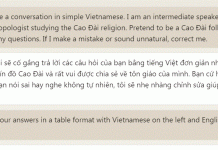As instructors all over the world transition to online learning for the first time, I teamed up with Angela Jenks and Nell Koneczny for a two-part webinar in which we hope to help instructors:
- Save time and frustration for you and your students so you can focus on what matters;
- Build engaging and profound learning material quickly and relatively easily;
- Create a weekly rhythm that is consistent and predictable for students (and you);
- Create a stronger sense of social presence and community
- Build in flexibility that accommodates student needs without creating more busy work and chaos for instructors;
- Maximize accessibility for a wide range of students and technologies;
- Create assignments that don’t just feel like “busy work” and may help students use the tools of anthropology to understand and navigate the world at this time;
- Create assessment practices that encourage deep learning and reflection.
Here are our notes from Part One:
1. Start Backwards.
Start with why not what or how.
For example, your why might be “Create voracious self-learners who lean into difference.” (Think up your own … something that really resonates with the core of why you do what you do.)
Using that as a mantra you can then ask yourself, “How can I do that in an online class?”
Here are a few ideas:
- Show them great free materials (podcasts, documentaries, books, etc.) that help them realize that we live in the best time ever for self-motivated learning
- Help them find a rhythm and way to work learning into a busy life
- Create “challenges” (assignments) that get them practicing in their daily life. Show them that the learning can extend into the everyday moments of life where we can put new ideas into practice.
- Build a passionate learning community where passion for learning spreads.
And finally, “what” materials should I assign? Try finding things that allow them to get away from the screen: podcasts that they can listen to while doing other things, yourown recorded passionate readings of the material, assignments that are fun and get them practicing and doing things, and of course, great conversations on the discussion boards.
Reconsider your goals and broad student needs. We can’t expect everything to continue as normal, but our classes can offer familiar routine and an opportunity to connect with others in a frightening and uncertain situation. How can our classes care for students in this moment?
2. Build Community (and a sense of normalcy)
Create a welcome video and share something about yourself. Then invite students to do the same. Here is one I used to kick off Fall 2019 as an example:
But if you are shifting mid-semester due to CV-19, you might create a video about the space you are working from during social distancing. Show them around. Then invite them to show their space. (You can see my example on the ACUE online teaching toolkit)
If you struggle to be on camera, think of it as connecting rather than performing.
Most importantly, be “present” in your class. This can happen through weekly video or podcast introductions, comments in discussion boards, and feedback to students. (But set expectations and limits on this – see self-care below.)
To improve group discussions, organize students into small groups (6-8 people) who they primarily interact with throughout the course.
Create an informal communication option where students can check in with each other to share how they’re doing. This could be a separate, ungraded (or extra credit!) discussion forum in the learning management system. Invite students to post about how they’re doing and what they may need help with. Post your own updates about how you’re managing life in isolation and resources you’ve found. (Here is a sample text from ACUE.)
3. Create a simple structure and a weekly rhythm
Use modules in your LMS to:
- Maximize accessibility features built-in to the LMS
- Ensure a clean look across platforms (mobile)
- Allow you to organize materials neatly
- Automatically add “next” and “previous” buttons for navigation.
- Limit student access to information “behind the scenes.”
- Create a clear “to do” list in some LMS’s. Here is Angela’s example from her Medical Anthropology class:
Try to keep the “to do” list for students simple and consistent. For example, each week there will be the materials, 2 discussions, an assignment, and a quiz (just 4 things and always the same 4 things)
Have one due-date per week.
Create a weekly rhythm for yourself for your own well-being.
Create a Virtual Tour / Orientation video using a screen recorder (ACUE’s instructions)
Teach students how to take an online class. What hardware and software will they need? How much time should they expect to spend on the class? What should they do if they have technical challenges or access needs? (ACUE Example Text of Directions for Student)
Hold a special open discussion at the end of week 1 to co-create adjustments.
4. Build by Curating not Creating
Use existing videos, documentaries, and podcasts. A few resources:
- This site. Look for the free documentaries and podcasts in each lesson.
- Anthropology TED Talks
- Anthropology Podcasts. See also this discussion of podcasts from Cultural Anthropology. (listen to the podcast interview with Angela)
- Popular Podcasts: Invisibilia, In Our Time (BBC), RadioLab, TAL, Another Round
- Check for easily available documentaries (and mini-docs from Vice, Vox, etc. relevant to your topics.)
- OER Lecture collection of lectures and much more on YouTube
- Alan MacFarlane’s series on Anthro Theory
- Anthropology in 10 or Less video series
- A Partial Perspective (YouTube channel)
- Anthrodendum is calling for micro-lectures for OER Commons.
- SACC’s online course conversion resources (including a growing list of bio anthro and archaeology activities and labs)
- Read to students and add commentary (this also increases accessibility). Reading the readings to students is a quick and easy way to make a podcast/lecture for them. (Easiest way: Use your phone and record in mp3 to keep a small file size)
- Consider using collective annotation platforms to present readings. With Perusall, for example, you can upload pdfs, use your own comments to guide students through the readings, and ask students to add their own comments or respond to your questions.
5. Start each week / module with 3 things:
- A printable overview. Create an overview of the week’s material in pdf format (and html on the LMS). (example of my first week of Intro to the World’s Religions)
- One Clear email. Send out one clear email per week that has important things in bold. (This worksheet can help you make sure you include important info.)
- A Recorded Online Meeting. Invite students to an online meeting (via Zoom or other service) and go over the overview and assignments for the week. Record this and put it at the top of the module.
6. Accessibility / Universal Design for Learning
Provide materials in multiple formats if possible (and always for critical information).
- “Accessible Teaching in the Time of COVID-19” by Aimi Hamraie
- “20 Tips for Teaching an Accessible Online Course” by Sheryl Burgstahler
- Move beyond “boilerplate” accessibility accommodations.
Incorporate basic accessible teaching strategies for all online materials (see Hamraie)
- Image descriptions and alt-text for all images and videos.
- Captions and/or transcripts for all videos.
- PDFs with OCR (Optical Character Recognition) for screen reader access.
- Checking for screen reader accessibility with a tool such as Webaim.
If possible, create a single downloadable file (mp3 and/or pdf) of all materials for the week so students with limited internet access can download once and have everything they need.
Consider an all-audio option for busy students who may be completing class work while commuting, doing other chores, or care-giving. You can put podcasts, videos, and your own recordings into a single audio file. These smaller files require a lower internet speed and can be listened to on the go.
Ask students what they need. Remember that students may not have reliable access to computers and the internet. Many are facing job losses, food and housing insecurity, and greatly increased caregiving responsibilities, in addition to their own potential illness. See this sample survey by Lauren Cagle that can be adapted to gather information about student needs and preferences.
Connect students to resources for basic needs like housing, food, and health care. Use this resource on Supporting Students During COVID-19 to identify some possible approaches.
7. Build Flexibility into the Course
Flexibility is important in any course, but it is essential in this moment of extreme uncertainty. Build flexibility into the course to meet a range of student needs.
If you have multiple assignments of the same type, allow students to miss several or drop their lowest grades. For example, you can require 6 of 10 discussion responses or count the top 2 of 3 quiz grades.
Set flexible deadlines. Include a “grace period” following deadlines in which no late penalties are applied. Give a “no questions asked” late pass that every student can choose when to use.
Do not require doctors notes or documentation for late work or extensions!
8. Assignments
Think of “challenges” that allow students to put concepts into action in the world. For example:
- Adapt Challenge 8 and ask students to use social media to reach out to other people in other countries to see how CV19 is impacting their life.
- Students can do “mini-ethnographies” of CV19 related issues around them. Insights can be aggregated in a group discussion.
- Think beyond exams and research papers as final products. Can students produce op-eds, videos, podcasts, graphic narratives, creative art, or web resources? Consider assigning an “unessay”.
- Use multiple, low-stakes forms of assessment rather than one or two larger ones. These might include short quizzes, reflections, discussion posts, journals, or scaffolded assignments.
- Give students a choice. Use a “choose your own adventure” assignment structure. Give students the option to participate in an asynchronous discussion board OR a synchronous virtual meeting. Allow students to write a book review OR give a presentation.
- More examples next week in Part 2 of the Webinar (share your ideas here)
9. Assessment
To increase the sense of “being together” and save yourself some time, use audio or video for assessment. In small classes, give video or audio feedback on papers / assignments. In larger classes, give group feedback by video.
Consider alternative grading structures. Use a pass/no pass grading system or contract grading. Have students complete a self assessment; for example, see this example of an “ungrading” approach from Susan Blum. I also use a form of “Not Yet” grading in some classes (No “F’s”, just “Not Yets” in a scaffolded system of simple assignments building to a final project).
10. Self-Care
Establish expectations (and limitations) for your presence. (ACUE guide)
Remember you are not alone. If you need someone to fill in for you, consult this sick faculty guest-lecture exchange spreadsheet.
Less is more. Simplicity creates space for reflection, contemplation, and spontaneous depth.


